The new role of the agricultural engineer in the digital age
By Laura Malàge, agricultural engineer at Sima
For this edition of Revista Cultivar Máquinas we present the field test we carried out with the Yanmar tractor, model YM347A. This Yanmar tractor offered in Brazil is a global project from the brand, designed and manufactured in Japan and assembled in Brazil. It is the same tractor that is used on Japanese farms and in other countries where the manufacturer sells its products.
To take it to the field, verify its performance and application, we have the support of the Sol dealership's Montenegro store. The municipality of Montenegro is located in the metropolitan region of Porto Alegre, 62 km from the capital. From there, we went to the Backes family property, in the municipality of São José do Hortêncio, 36 km away from the dealership store.
Among crops of citrus, bergamot and oranges, lots of cassava and vegetables, we were able to find an area to work on mowing and spraying, to check the functioning of this tractor and learn about the characteristics and virtues that so pleased these customers.
The tractor we tested has an open, platform-type operating station, but the dealership offers the option of an optional cab version, through a partnership with another company that manufactures and installs a cab, with air conditioning.
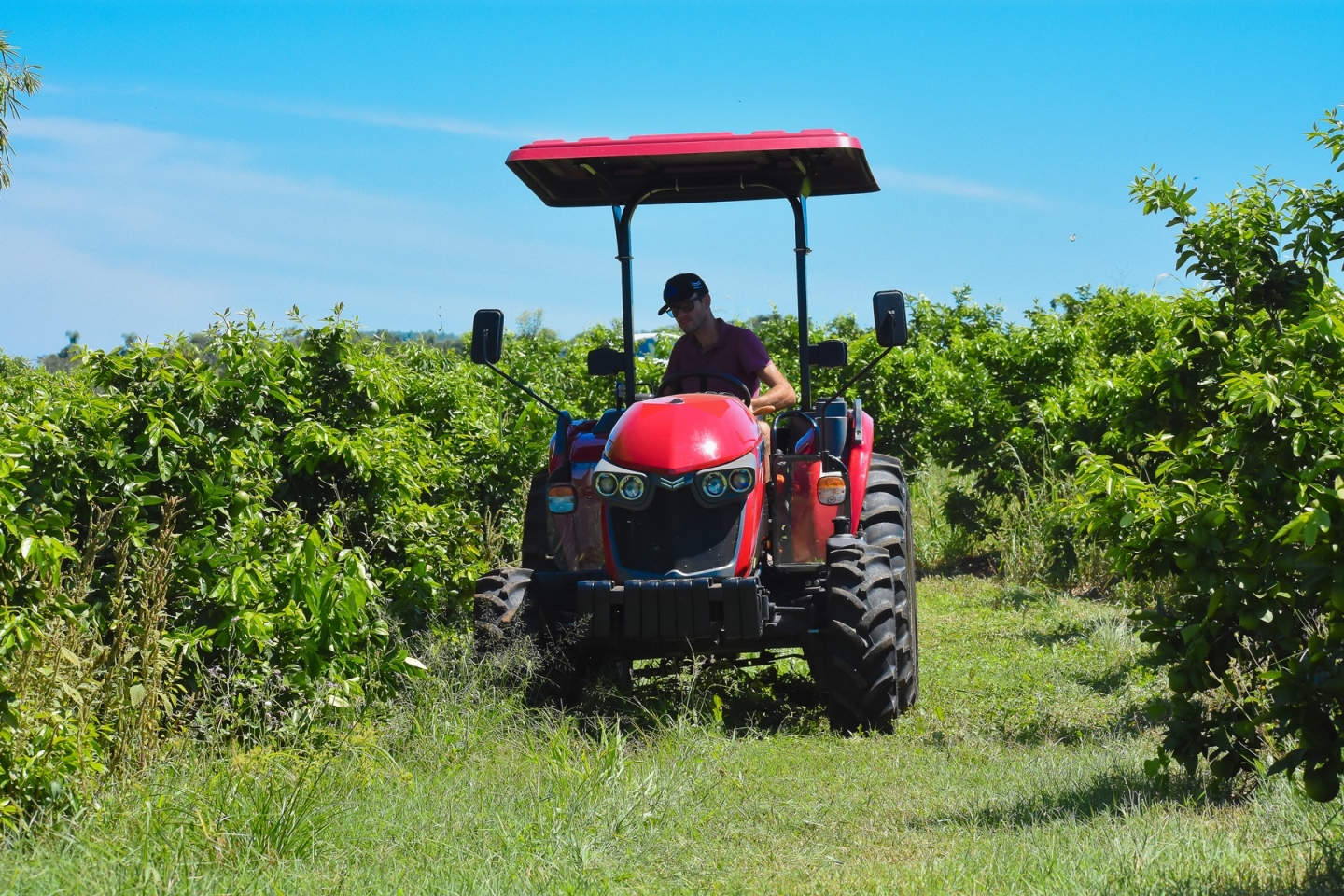
By opening a tilting hood, we access the YM's engine, which is from the Yanmar brand, model 4TNV88-BKITL, with four cylinders, natural aspiration, direct fuel injection and cooled by liquid circulation. The engine has four cylinders and a total volume of 2.190 cm³. It uses a cold start support system using a glow plug, placed in the combustion chamber. Unlike other larger tractors that we tested in previous editions, the engine's operating speed is 2.800 rpm, where maximum power of 47,6 hp is obtained. This series of TNV engines is manufactured in Japan, meets various environmental legislation and, therefore, obviously complies with emissions regulations, international Tier 3 and MAR-1 standards for Brazil.

Considering the position in which the engine was installed in the compartment, it appears that there is plenty of space for the installation of options, such as the air conditioning compressor, a turbocharger, if applicable, even if this equipment is not approved by the manufacturer, but which are usually sought after by customers. Assemblies of relays and fuses were placed in front of the radiator. And on the left side, the coolant expansion reservoir. The battery was installed close to the hood lock in front of the radiator.
In the upper part of the engine you can see the set of two air filters, one main and the second for safety. Due to its position, it is very easy to clean, which the manufacturer encourages to be done preventively and with all precautions, as the paper element requires care. On the right side of the engine, the project included the fuel filters, the first for decantation on the outside of the fairing and the main diesel filter, inside the fairing, which can be easily removed using three small screws. There is a sensitive concern regarding this item, due to the lack of fuel quality in our country, and that is why we checked the ease of maintenance of this item.
The fuel injection pump is rotary, from the Yanmar brand, and the system provides assistance to the user by installing a self-priming electric pump, in cases where it is necessary to facilitate bleeding, which is the removal of air from within the current. of the fuel. The engine also has coolant temperature sensors and engine lubricating oil pressure measurement.
At the power transmission input there is a dry disc clutch, which connects the engine to a synchronized gearbox with eight forward and eight reverse gears, which is made possible by the presence of a direction reverser that uses a double cone synchronizer, innovative, for which the manufacturer holds industrial property rights. However, it is possible to consider that this transmission is a 12 x 12, as in the standard assembly the YM comes with a super-reducer, creeper, which adds four more reduced speed gears, forward and backward.
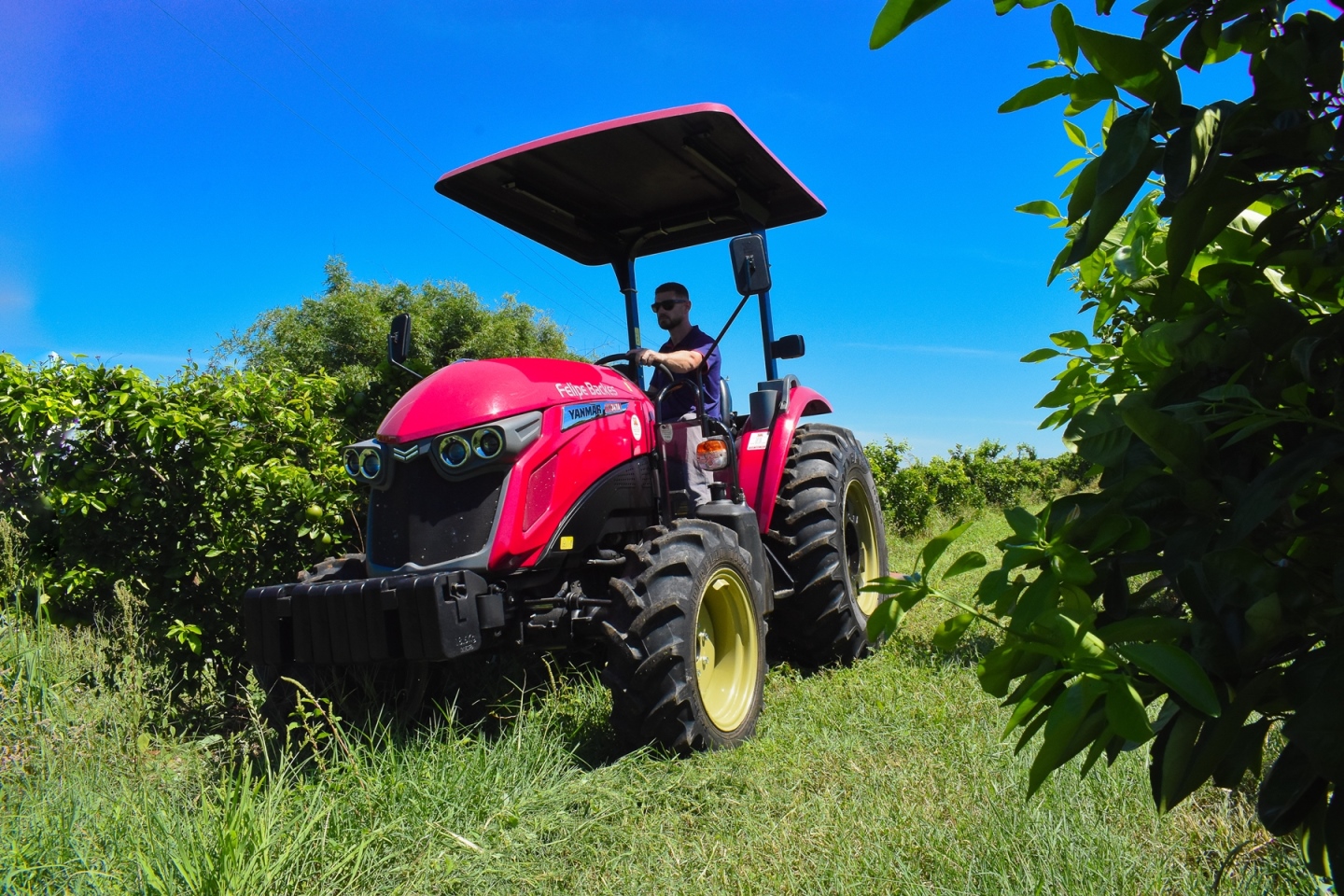
The entire transmission system formed by the gearbox, differential and final reduction, which is epicyclic, is produced by Yanmar and uses the same oil as lubricant in all compartments.
Due to the potential use of this tractor, on small properties and with a variety of terrain and operations, the manufacturer prudently placed a protector on the transmission system, to prevent damage in the event of collisions with obstacles. During the test we saw that there were stones and chameleons in places of transit and movement.
The front axle of this tractor deserves to be highlighted, as it is armored, the type that uses pairs of conical gears instead of crossheads, as in several models manufactured in the country. This provides an elevation of the axle in relation to the wheels, increasing the free space, in addition to being sealed against water entry, which reduces problems and the need for corrective maintenance. The turning radius also decreases with this construction, as the steering angle reaches 55º. During the test, we verified how easy it was to get out and into rows close to citrus trees, with little space. The same lubricant, specified SAE 85-90, is used on the entire front axle.

The hydraulics of the YM347A are from the Ferguson system, with actions to raise and lower implements with the aid of two levers, one for position and the other for fluctuation, with sensitivity adjustment when lowering heavy implements. The third point of the implement connects to the tractor through the C beam.

One of the best evaluated points in the test and which coincides with the customer's evaluation is the PTO on and off switch, placed on the right side of the seat and which allows, when maneuvering, the operator to quickly turn off the PTO, interrupting his functioning and connecting it quickly when operations resume. This electro-hydraulic drive greatly favors speed, product savings and environmental preservation, especially when working with the sprayer, between the citrus rows, as is the case with the Backes family.
The remote control system is double, with two VCR valves, one of which can be placed on float, for implements that require continuous oil flow.
For transport, the manufacturer installed a valve that locks the hydraulic system, acting as a safety element, preventing shocks that could damage the hydraulic components. The differential lock can be activated with the operator's right foot, by pressing a small lever.
The power take-off (TDP) has shield-type protection to prevent people from coming into contact with this shaft. It can be used with a speed of 540 rpm to 2.784 rpm and in economical form, 540E at 2.016 rpm. Changing from one form to another is done by pressing a lever, placed to the left of the operator's seat.
We consider an interesting difference to be the way the manufacturer provides the use of two categories of hydraulic system. In the same eyelet, there are two different holes, one for each category. When engaging the implement, the operator simply turns the ball until he finds the hole with a diameter compatible with the transverse axis of the equipment to be coupled.
The rear axle uses the same oil for the hydraulic system, transmission, final reduction and differential.
The YM347A operator's station is a platform type, with access via a single-step ladder on the left side of the tractor. The operator's seat can be adjusted for weight, height, advancement and backrest position. As a safety device, the tractor can only be started if the operator's weight is on the seat, the reverser is in the neutral position and the hydraulic system is in the lowered position. Even with the tractor running, if the operator leaves the seat, the engine is turned off. As this tractor is developed for the Japanese market and others with high demands, even though it is small, it has elements to guarantee the safety of the operator and other people involved in the activity.

On the front part in front of the pedals, the manufacturer placed a glass barrier to prevent the heat resulting from engine operation from reaching the operator's feet and legs. On the floor, on the left, the fuel tank projects below the platform, which, together with other measures, reduces the tractor's center of gravity, which is extremely effective in increasing stability on slopes.
For lighting, Yanmar placed an LED rear light for implements and a set of halogen headlights with a projector at the front. The other sound signaling and lighting items are present, as determined by standards.
To the left of the seat are the group levers, the PTO rotation speed levers, the auxiliary front traction lever and the parking brake. For storing items, the YM347A has an open storage compartment on the left fender, on the right side in front of the platform a tool box and behind the seat back, a document holder. A 12 V socket was also placed to connect electronic components and a main switch was positioned at the front of the tractor, to cut off the electrical current. A fixed rollover protection structure (EPC), with manufacturer approval, is also available. We checked several items during the test and Yanmar technicians confirmed that the model that arrived in Brazil fully meets the requirements of Regulatory Standard 12, from the Brazilian Ministry of Labor and Employment.
A very interesting differentiator of this model is the SA-R system, Smart Assist Remote, which is Yanmar's telemetry, and is standard on the YM347 model. Through this system, both the manufacturer and the dealer can monitor the individual work of each tractor, receiving online positioning information, the number of working hours recorded on the hour meter and error codes referring to alerts for problems resulting from lack of oil pressure and engine coolant temperature rise. This allows the manufacturer and dealer to monitor maintenance and warn the customer in the event of operating abnormalities.
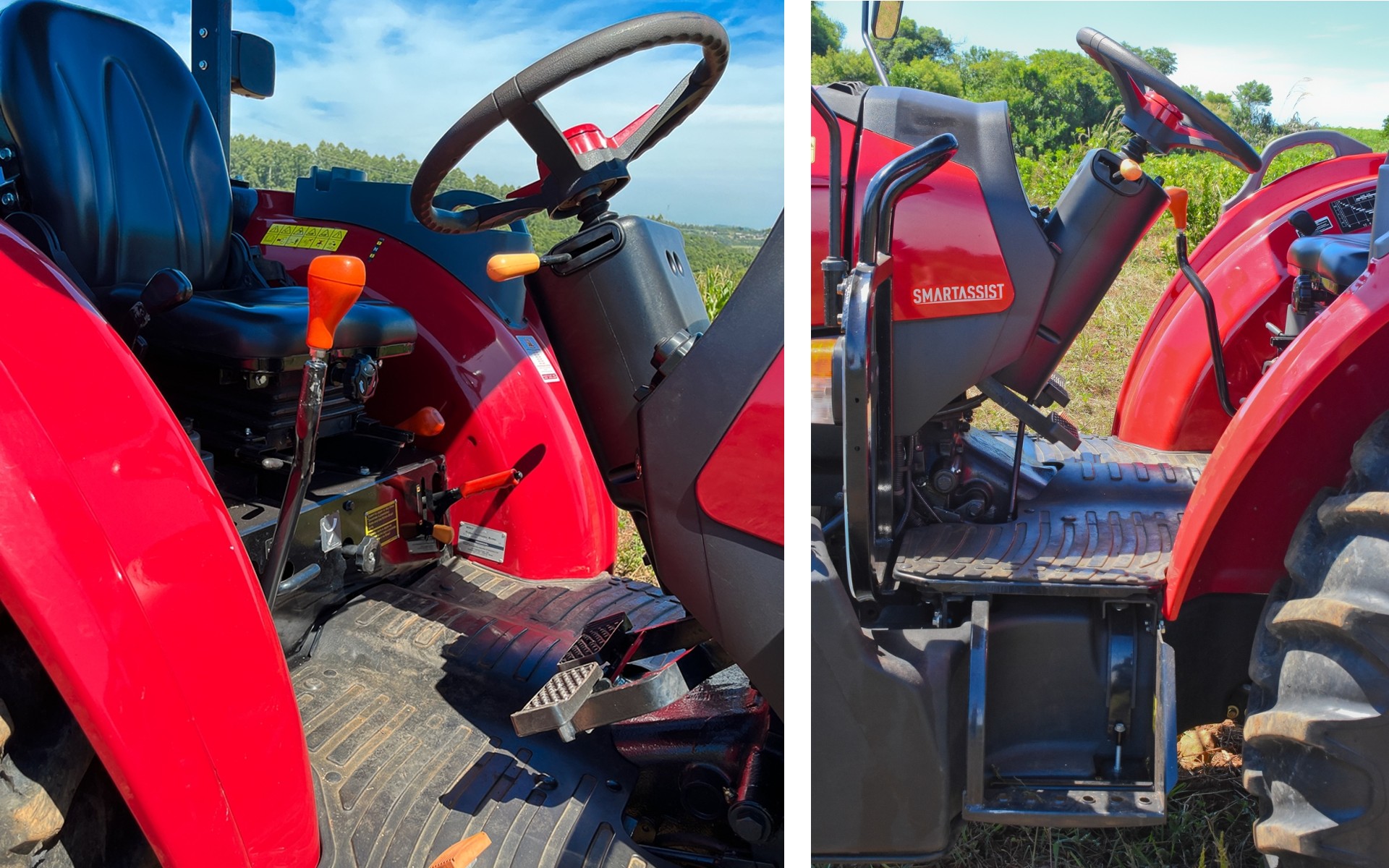
During the field test we were interested in appreciating the functioning of the main items such as engine performance, operation and facilities provided by the transmission and hydraulic system, but mainly the items mentioned by the customer and user, after the hours of work he has already developed since the acquisition.
The small turning radius required for headland maneuvers is notable, which we were able to see due to the ease with which the tractor equipped with the sprayer was able to exit and enter the space between the trees. Sometimes, larger equipment or longer tractors with non-steering front axles need to do the work alternating rows and rows in order to be operationally efficient. The YM347A easily left and entered the rows next to it, even without using a differential brake.
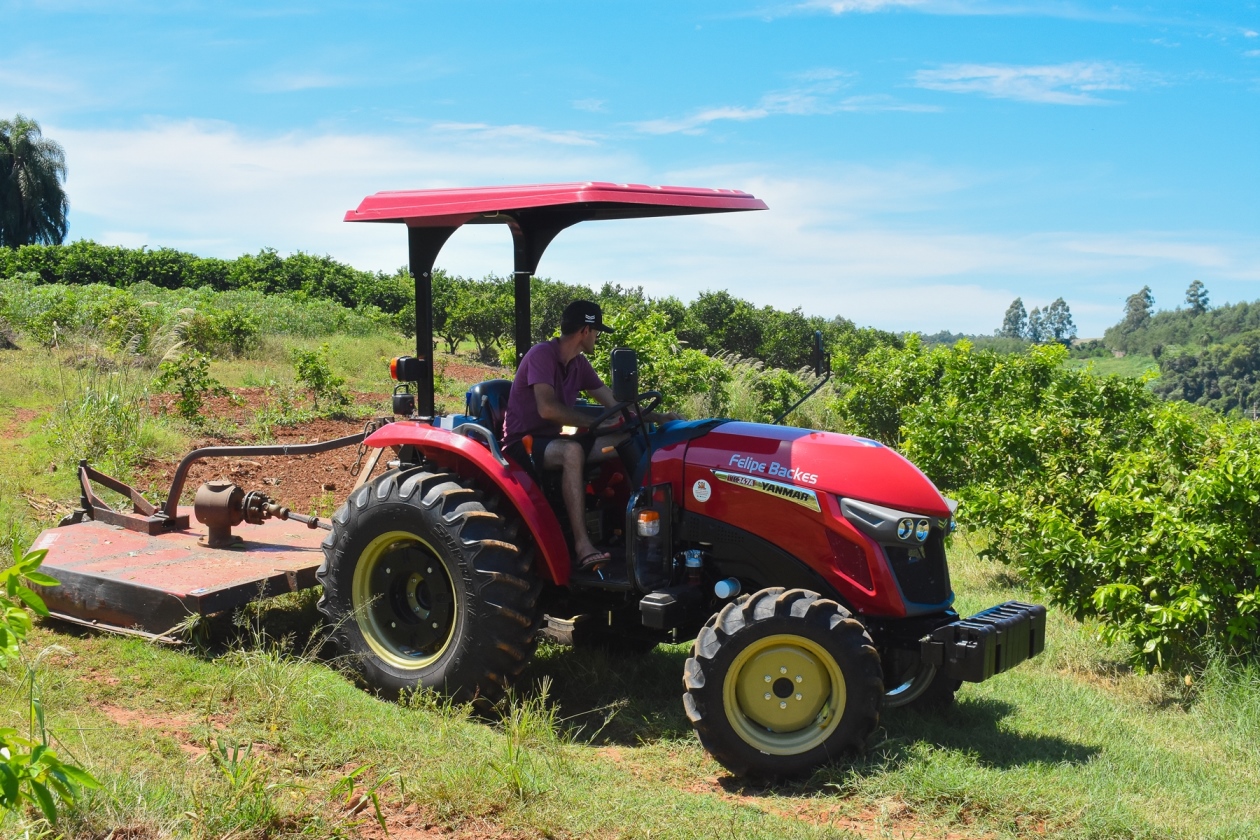
We did not measure fuel consumption with either of the two pieces of equipment we used, but the dealer's expectation of an average of around three liters per hour was contested by the customer, who stated that on average across all his operations, consumption was below that. Therefore, from customer experience, fuel economy is one of the positive points of this model.
As for technical assistance, the customer considers themselves very satisfied, renewing their tractors with models from the same brand. In addition to the YM347, he has another Yanmar on the property and is considered a promoter of the brand in the region.
Another item that we evaluated positively during the work was the free space, considered very good for this power class. The front axle provides significant ground clearance and the lowest heights are at the rear, close to the differential and transmission protector.
We were also asked to evaluate longitudinal stability, as customers who use a tractor of this class often use heavy, long equipment at the rear connected to the hydraulic system. To contain this movement, the manufacturer designed the placement of up to nine front weights, each weighing 18,6 kg. Furthermore, there is a huge lever arm between the center of gravity of the weights and the plane of the front axle. It is also possible to increase front weight by ballasting the front tires with water. To increase the weight of the rear wheels, in addition to the hydraulic ballast, each wheel can receive 80 kg metal discs. The tires that equip this model, which are most widely used in the region, are 250/80-18 specification on the front axle and 14.9-24 on the rear wheels.

Founded in 1912 in Japan under the name Yamaoka Hatsudoki Kosakusho, the company changed its commercial name to Yanmar nine years later, when it produced its first Diesel engine. Consolidated worldwide as an engine manufacturer, Yanmar has a history closely linked to the manufacture of tractors in Brazil. When the federal government tried to implement the national tractor industry at the end of the 1950s, Yanmar established, in 1957, its office in the city of São Paulo and, in 1960, opened its first Diesel engine factory in Brazil, under the name of Yanmar Diesel Motores do Brasil S/A, in the municipality of Indaiatuba, state of São Paulo.
In 2009, Yanmar expanded its field of activity, entering the civil construction segment with the sale of mini excavators and mini loaders. In 2012, the company celebrated its centenary, while in Brazil it has been present for 66 years.
Strengthening itself worldwide, in 2018 Yanmar signed a partnership with the tractor manufacturer ITL – International Tractors Limited – which currently exports to more than 120 countries, including highly competitive markets such as the United States and Europe and owns the Solis and Sonalika brands. . Furthermore, by signing a partnership with ITL, it became the owner of the Solis brand. Currently in Brazil, Yanmar offers 12 tractor models in its portfolio, with versions from 26 hp to 90 hp. Yanmar returns to using the Yanmar name on tractors, initially with the Solis 70 hp and 90 hp versions, manufactured in Brazil, and the 26 hp and 60 hp models imported. Thus, Solis (“supported by Yanmar”) was born in the Brazilian market, estimated to hold fifth place in tractor sales share in the country.
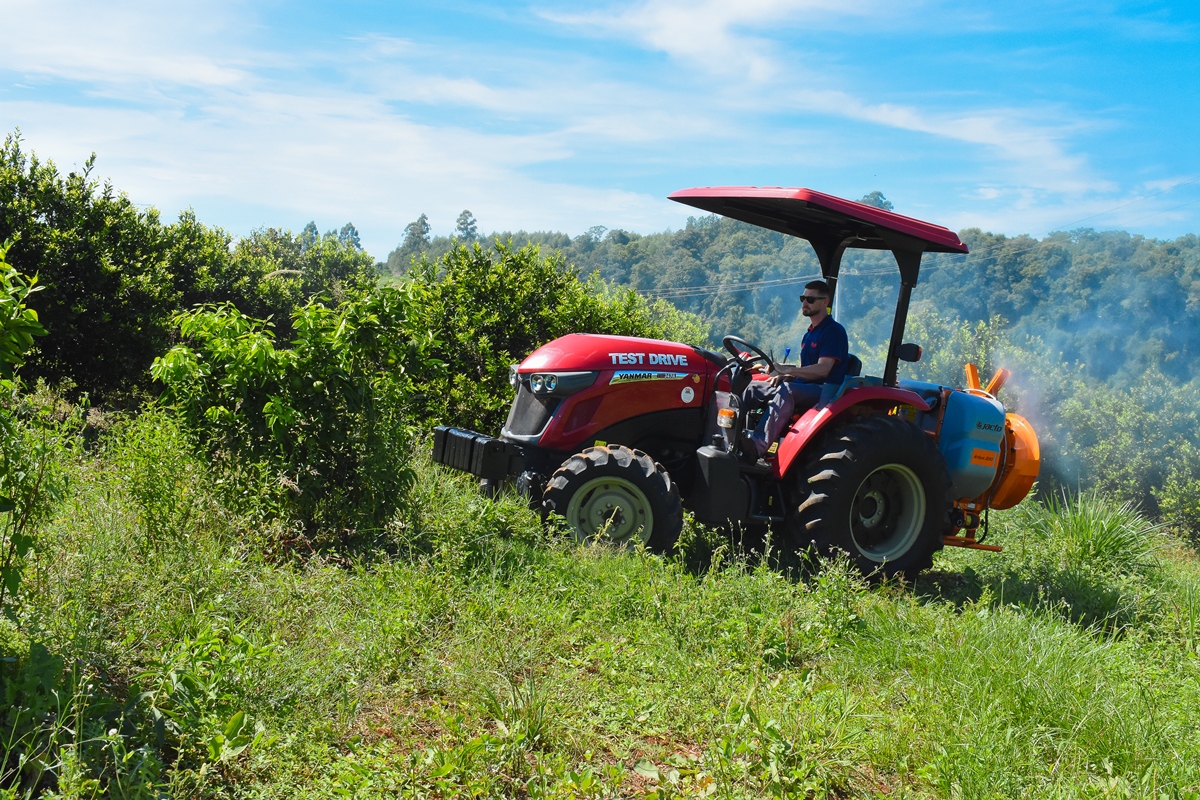
The Sol dealership network operates with stores in the cities of Montenegro, Caxias do Sul and Vacaria across a vast region of the state of Rio Grande do Sul. They were present and helped us during the test, the dealership manager, Marcos Milech, with the support of the commercial, Daniel Luft, and technicians Juan Lorenz and Geraldo Nonnemacher, the latter was recently congratulated with second place among the best Yanmar technicians in all of Brazil.
For this edition's Test Drive, we went to the city of São José do Hortêncio/RS, which is 35 km from Montenegro. São José do Hortêncio as a municipality was founded in 1875, but its formation process occurred due to German colonization, with immigrants in Vale do Caí, starting in 1824.
At the Backes family property we were very well received by Mr. Adelário, Mrs. Lígia and their son Felipe Backes. The Backes family dedicates more than 25 hectares to citrus cultivation, including oranges and tangerines, as well as cassava, vegetables, corn for silage and small pasture for cattle. The Backes family sends the majority of its production to the Rio Grande do Sul Supply Center (Ceasa) in Porto Alegre, mainly in the citrus harvest, transporting more than two thousand boxes per week.
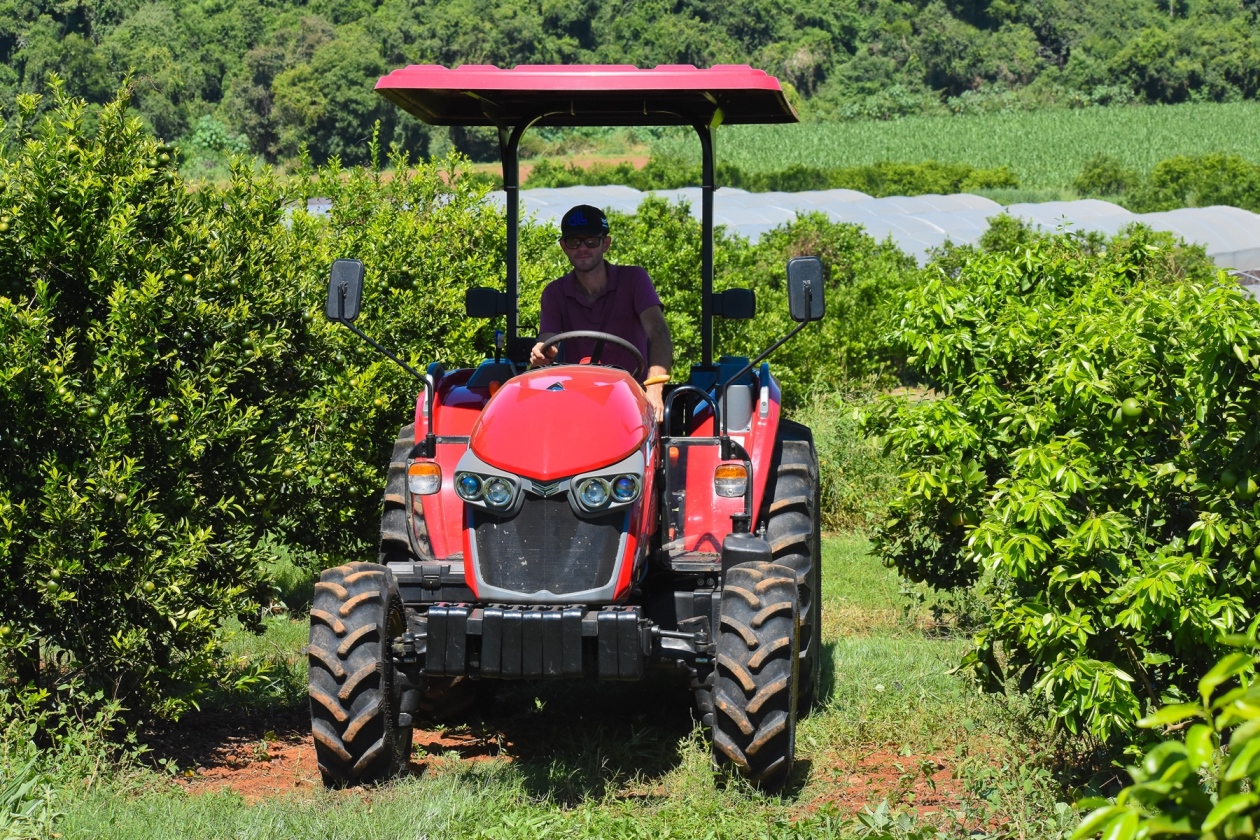
On the Backes family property, the Yanmar tractor is used in conjunction with numerous agricultural implements, of which we were able to observe in operation, a turbo atomizer with a capacity of 550 liters and a brushcutter with a usable cutting width of 1,80 meters. This tractor also uses a rotary hoe with a useful width of 1,75 meters, a four thousand liter tank for distributing manure and an agricultural trailer.
According to Mr. Adelário, the decision to purchase the Yanmar YM 347A tractor was due to his knowledge of the brand and the service provided by the dealership. They currently have a Yanmar Solis 75 tractor, equipped with a 1.200 kg capacity scoop, which is 3,5 years old and has 1.200 hours on it, but they had a Yanmar model T50 tractor that they used for 10.000 hours. But the biggest influence on the acquisition was his son Felipe, who carried out several agricultural operations with a test model and has since decided to buy it.
The test drive was carried out in a citrus area, the traditional bergamot, known as such in the State of Rio Grande do Sul. These were planted in spacings of 5 mx 5 m, in which agricultural pesticides and mechanical control of invasive plants are applied. .
According to Adelário and Felipe Backes, the tractor that was purchased in September 2023 currently has 155 hours, has good traction performance and the gears are suitable for all types of work.

They also reported that the power take-off button is simple and practical, facilitating operations in small spaces. The perception of lower fuel consumption, the free space to work with certain crops and the ability to perform maneuvers in areas with a lot of slope were the main points highlighted by them.
Ultimately, we consider the experience with a tractor with Japanese DNA to be good and with a lot of applicability in small area properties, which require versatility, reliability, efficient technical assistance and low cost of use and acquisition, in addition, of course, to features that allow maneuverability and stability, due to the working conditions they must comply with. Due to the activities we develop and the equipment we use, we highlight as strong points the engine's ability to withstand high torques, lateral and longitudinal stability and maneuverability to move in small spaces, especially those resulting from maneuvers. Customer testimonials were also important in confirming the quality of technical assistance and fuel economy.

Receive the latest agriculture news by email